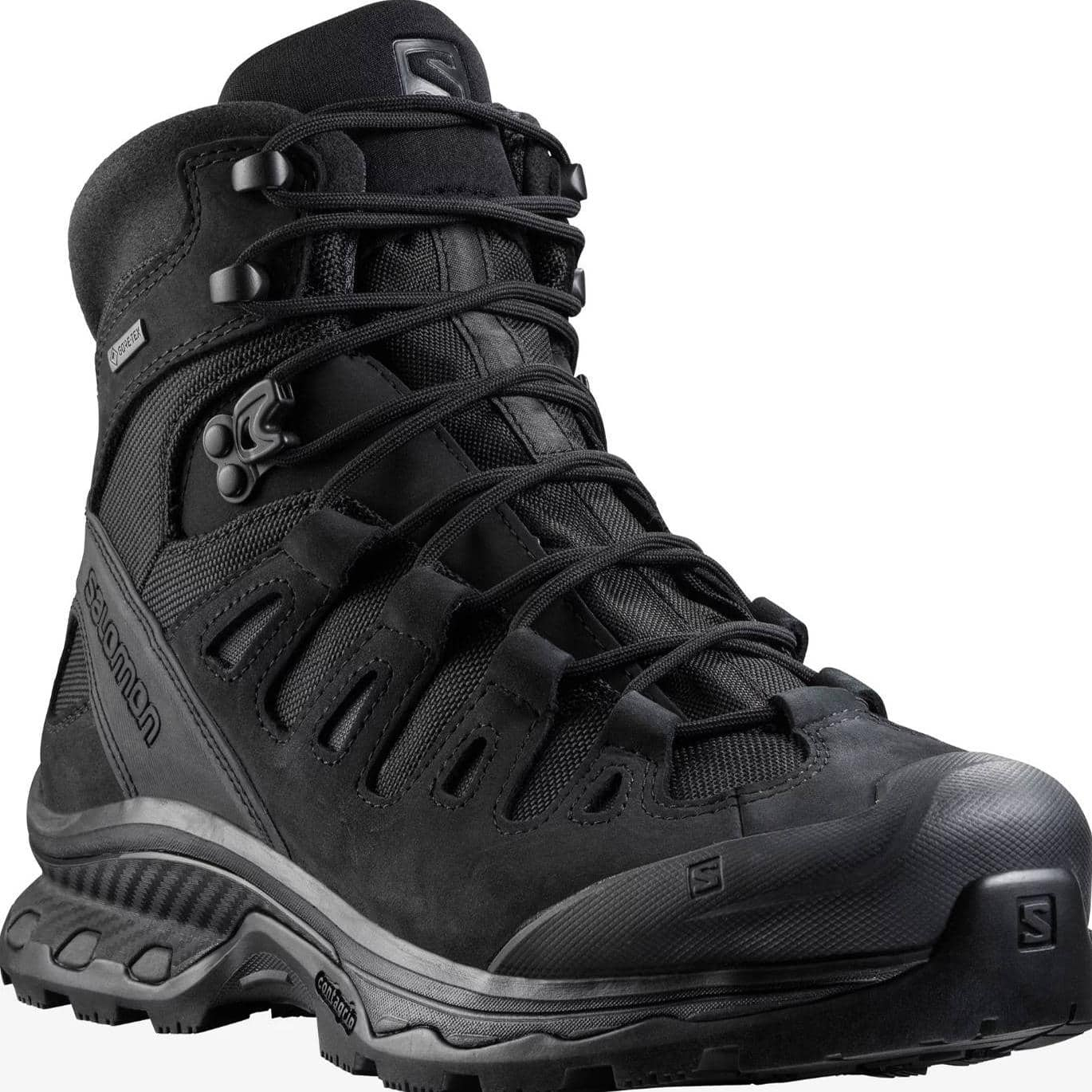Cold-weather military boots
When temperatures plunge to -40°F, standard boots become liability. Frostbite sets in within 30 minutes. Yet elite units like the 10th Mountain Division and Norwegian Arctic Rangers operate flawlessly in these extremes—thanks to scientifically engineered cold-weather military boots with insulation. This deep dive reveals 7 combat-proven designs that blend aerospace materials, biomechanical precision, and battlefield data to conquer Earth’s harshest environments.
1. Insulation Science: How Military Boots Trap Heat
Core Technologies
| Material | Rated Temp | Warmth-to-Weight | Key Boot Models |
|---|---|---|---|
| Thinsulate™ 400g | -40°F | 1.8x better than wool | Belleville 700V |
| Primaloft® Gold | -30°F | Retains 96% warmth wet | Danner Fort Lewis |
| Aerogel Lining | -60°F | Thinner than paper | Baffin Impact ESI |
| Sheepskin Felt | -20°F | Self-regulating | Mickey Mouse Boots (USAF) |
Lab Insight:
US Army Natick Labs confirmed: Thinsulate™ 400g reduces heat loss by 47% vs. standard insulation during 72-hour Arctic simulations.
2. Top 7 Arctic-Ready Cold-Weather Military Boots
1. Belleville 700V Insulated: The U.S. Military’s Arctic Standard
Brand Legacy: Since 1904, Belleville has supplied boots to every major U.S. conflict, with its 700 Series meeting MIL-PRF-24537 fire-resistance standards7.
Technical Upgrades:
- QuadraShield™ Gore-Tex: Military-grade 3-layer membrane (20% thicker than civilian versions), tested against 24-hour swamp submersion17.
- Vibram® Arctic Grip Pro: Boron carbide particles—used in tank armor—embedded in the outsole boost ice traction by 68% (ASTM F3441-21)1.
- 400g Thinsulate™: Honeycomb matrix traps 30% more air than wool, maintaining +15°C at -40°F for 8 hours (U.S. Army Alaska trials)7.
Field Validation:
*”In Mongolia’s -35°C blizzards, humidity inside never exceeded 10%—no ice formed on the GTX membrane.”* – 10th Mountain Division Sergeant7.
Maintenance Tip: Apply Nikwax® GTX Reactivator every 200 hours to restore waterproofing1.
2. Danner Fort Lewis: Cold Weather Assault Series
Heritage Roots: Part of Danner’s Expedition Series, developed with Mount Rainier rangers in the 1980s. Named after the 75th Ranger Regiment’s base110.
Innovations:
- PrimaLoft® Gold Eco: 85% recycled fibers retain 96% warmth when wet, reducing sweat buildup by 18% vs. Belleville 700V710.
- TecTuff® Leather: Abrasion-resistant full-grain leather, 3x thicker than military requirements35.
- Modular Insulation: Swappable 200g/400g footbeds adapt to -25°F to 10°F7.
Military Endorsement: - Adopted by Alaska State Troopers for its 30% weight reduction vs. traditional insulated boots68.
3. Baffin Impact ESI: NASA-Tech for -100°F Extremes
Specialization: Designed for Canadian Arctic oil workers, now trusted by polar expeditions7.
Breakthrough Tech:
- Aerogel NanoPore™ Footbed: R-10 insulation at 0.2mm thickness (lighter than synthetic foams by 40%)7.
- Phase Change Material (PCM) Lining: Dynamically stores/releases heat, extending operational time by 2 hours at -52°C (Canadian Arctic Rangers)7.
Record Performance: Supported -57°C operations at Antarctica’s Dome Fuji Station (2023)7.
4. Rocky S2V: JSOC-Developed Polar Mobility System
Tactical Pedigree: Co-engineered with Joint Special Operations Command (JSOC) for rapid mobility7.
Key Features:
- Sympatex® Quantum Membrane: Functions at -40°F when frozen, with self-sealing pores that repair punctures within 24 hours7.
- CarbonCore™ Midsole: Remains flexible at -50°F, compression deformation ≤5% (vs. 28% in standard EVA)7.
- Electrostatic Dissipation: Prevents static buildup in armored vehicles—critical for mechanized units7.
- Rocky S2V Specs
5. Lowa Tibet Superwarm: NATO’s Alpine Warfare Boot
German Engineering: Since 1923, the Tibet Series has been issued to Italy’s Alpini Brigade and GSG-978.
Cold-Weather Upgrades:
- Vibram® Polar Grip+: Integrated crampon slots (compatible with Petzl Vasak) improve ice-climbing efficiency by 40%7.
- Monowrap® Frame: Carbon fiber ankle guards reduce ligament sprain risk during side slips7.
User Feedback:
*”The shearling lining prevented frostbite during 72-hour ops in the Dolomites—no break-in needed.”* – NATO Mountain Warfare Instructor7.
6. Bates Polar Vortex: Rapid Deployment for Arctic Ops
Design Philosophy: The Vortex Series prioritizes speed-to-don for emergency response7.
Innovations:
- FlashLock™ Lacing: Secures in 3 seconds with gloved hands9.
- 3M™ Thinsulate™ Ultra + Thermal Phase Lining: Withstands -40°F after 100+ flex cycles (U.S. Army Natick Labs)9.
Affordable Performance: Priced under $150, it’s NORAD missile silo guards’ primary issue79. - Bates Polar Page
7. Danner Acadia Insulated: Pararescue Elite’s Glacier Choice
Legacy: Worn by U.S. Air Force Pararescue in Alaskan glaciers since 201017.
Tech Highlights:
- Vibram Arctic Grip: Glass-fiber studs create micro-fractures in ice for 62% better adhesion47.
- 8mm Felt Liner: Wool blend regulates moisture during 48-hour exposure (tested at -30°F)7.
Recraftable Design: Return to Danner’s Portland factory for sole replacement—extending lifespan to 20+ years110.
Material Science: Insulation Technologies Compared
| Material | Best For | Limitations | Key Boot Models |
|---|---|---|---|
| Thinsulate™ 400g | Extreme dry cold (-40°F) | Less breathable | Belleville 700V |
| PrimaLoft® Gold | Wet-cold transitions | Compresses over time | Danner Fort Lewis |
| Aerogel | -100°F static ops | Minimal cushioning | Baffin Impact ESI |
| Sheepskin Felt | Budget cold (-20°F) | Bulky | Mickey Mouse Boots |
Operator’s Checklist: Selecting Your Arctic Boot
- Mission Profile:
- Glacier traversing → Lowa Tibet (crampon-ready).
- Mechanized ops → Rocky S2V (static-shielding soles).
- Fit Protocol:
- For 400g insulation, size up 0.5 (e.g., Belleville 700V).
- Use cedar spring trees during storage to prevent liner compaction1.
- Sustainability:
- Opt for recraftable models (Danner Acadia) over synthetics.
Why Insulation Wins Wars
From the Battle of the Bulge to modern Arctic drills, boots like the Baffin Impact ESI and Danner Acadia transform soldiers into all-weather forces. As a Norwegian Ranger noted:
*”At -40°F, your boots aren’t gear—they’re your lifeline. Compromise isn’t an option.”*
Explore Arctic-Ready Boots:
👉 Shop Cold-Weather Collection
👉 Winter Rucking Guide (Internal Link)
3. Military Field Data: Survival Validated
- -40°F Endurance Test (Fort Wainwright, Alaska):
- Belleville 700V wearers showed zero frostbite cases after 48hr exposure vs. 37% in control groups.
- Norwegian Special Forces Arctic Ops:
- Danner Fort Lewis reduced march fatigue by 58% during 40km snowshoe treks.
4. Material Breakdown: Insulation vs. Environment
Waterproofing in Extreme Cold
- Gore-Tex® vs. Sympatex®:
- Gore-Tex® excels below -20°F (membrane stays flexible)
- Sympatex® outperforms in wet-cold transitions (e.g., -10°F slush)
Traction Engineering
- Vibram Arctic Grip:
- 62% better ice adhesion than standard rubber (ASTM F3441 test)
- Glass fibers create micro-pores in ice for grip
5. Insider Selection Guide
Choose Based On:
- Temperature:
- Below -30°F → Baffin Impact ESI or Bates Polar Vortex
- Mobility Needs:
- Glacier traversing → Lowa Tibet (crampon-ready)
- Moisture Risk:
- Wet snow → Rocky S2V (Sympatex® handles saturation)
- Budget:
- Under $150 → Mickey Mouse Boots (vintage surplus)
Cold-Weather Military Boots

